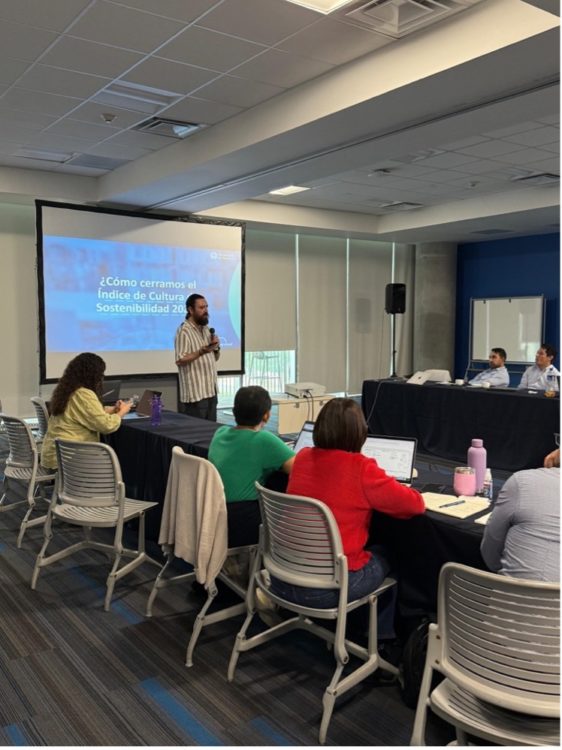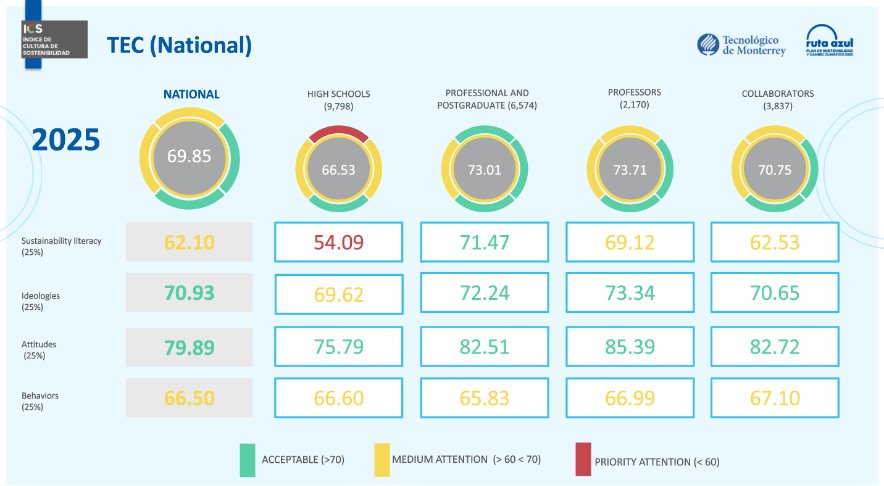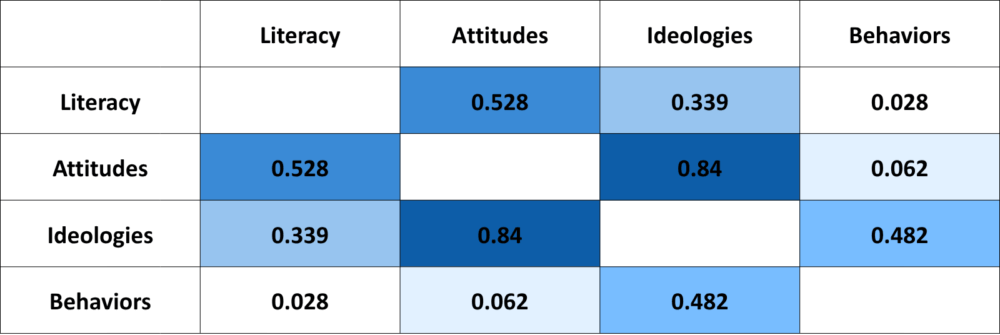2025 Award Winner: Tecnológico de Monterrey
How Tecnológico de Monterrey’s Sustainability Culture Index Is Transforming Campus Mindsets
Measuring sustainability should never be only about counting emissions or tracking recycling rates. The real challenge lies in understanding the link between the intangible: the beliefs, attitudes, and values and the tangible: how individuals and communities act toward the environment. How can we measure a culture of sustainability? How can we tell if pro-environmental behavior and a culture of sustainability have truly become part of who we are?
To answer these questions, Tecnológico de Monterrey, one of Latin America’s leading universities, developed the Sustainability Culture Index (SCI), an instrument designed to make the invisible visible. Now, in its second measurement cycle (2024–2025), the SCI has evolved from a diagnostic tool into a roadmap for cultural transformation, connecting data with action and understanding with impact.

The SCI was first developed in 2021 with the help of professors Florina Arredondo and Gabriel Cué from the School of Humanities and Education, under the academic leadership of Luis Fernández-Carril, Academic Manager of Sustainability. From the beginning, the project sought to build upon the relevant scientific literature existing on pro-environmental behavior to design the survey, including New Ecological Paradigm, as well as the Attitudes, Behavior Context model among other frameworks and conceptual approaches in the literature review, and what other universities were implementing on sustainability culture. The objective was to understand how knowledge, values, attitudes relate to sustainability behaviors, how they take root within a university community, how are these being measured, particularly with intangible elements such as attitudes and ideologies, how to understand different mindsets and ultimately, to motivate action and develop a culture of sustainability. The results of these actions include the design of educational and training courses for staff and faculty, a guideline for the inclusion of education for sustainable development in undergraduate programs, the design of competencies for the update in the educational model, among other actions. The findings have also guided the development of projects and programs, as well as key institutional decisions shaping sustainability policy, for example, the results informed the creation of guidelines for the design of sustainability courses and the design of competencies in all undergraduate programs, as well as the relevant expansion of credits given to sustainability.
In the curriculum design for the 2026 update of the undergraduate educational model, a total of 960 disciplinary credits—representing 29% of all credits—will explicitly incorporate the sustainable development approach. These credits are distributed across 205 courses, equivalent to 20% of all undergraduate programs. Each course will be developed following the course design guidelines informed by the SCI.
The 2025 edition marks a significant evolution of that initial effort and reflects a broader scope, a broader institutional collaboration, a big deployment effort and a more detailed, in-depth analysis. In this second survey cycle, the SCI broadened its thematic scope, refined its questions and expanded the level of analysis to capture a more comprehensive and nuanced understanding of sustainability culture in different topics, including willingness, knowledge of other visions or sustainability frameworks such as regeneration and local and indigenous knowledge, as well as more precise understanding of specific behaviors and level of engagement with institutional initiatives regarding sustainability.
This expansion was achieved through the inclusion of new team members: Jorge Zenil, leader of strategic projects; Kitzia Rodríguez, sustainability specialist; Luis Rojas, faculty member of the School of Humanities; and Eva Guerra, expert statistician from EGADE Business School. Together, they carried out detailed analyses, refined methodologies, classified information, and developed tools to interpret results, draw conclusions, and design strategies to drive action. The project also benefited from knowledge exchange with the University of Michigan and the Pontificia Universidad Católica de Chile.
Meanwhile, to coordinate the extensive logistics of the ICS, Dariela Parra served as the strategic lead for its implementation in her role as Culture Projects Manager. The overall leadership of Paola Visconti and Jaime Dorantes of Ruta Azul (Tec’s Climate Change and Sustainability Plan), together with the Direction of Operations and campus sustainability teams, ensured its successful implementation across Tec’s network.
A Deeper and Broader Measurement

The new edition engaged over 22,000 participants including students, faculty, collaborators, and health personnel from TecSalud (the university’s healthcare and hospital system). The results feed directly into institutional and campus sustainability plans and align with STARS (Sustainability Tracking, Assessment & Rating System) indicators, a global framework used by universities such as MIT, Stanford, and Berkeley. This second survey created a sustainability culture baseline in 20 campuses of Tec de Monterrey, a specific score for these campuses. The information resulted in an overall analysis of the Institution and analysis per campus, per faculty.
The 2025 results show an encouraging overall increase in the overall score (+3 points), a notable improvement from 2022 (66 points to 69 points /100). Yet they also reveal a persistent challenge in the gap between what people know, believe, and do. Sustainability has become a shared value but translating that awareness into everyday action and in its different social and cultural dimensions remain key challenges.

What the Data Reveals
The SCI’s four pillars, literacy, ideologies, attitudes, and behaviors, offer insight into a cultural gap:
- Sustainability Literacy: there is an elementary understanding of environmental issues and limited systemic thinking shaping a view of sustainability as merely an environmental topic, rather than an interconnected social and economic issue.
- Ideologies: There is a recognized concern for the need of social justice though poorly understood outside of a generalized basic concept. Technological optimism remains dominant throughout populations. Belief in technology and innovation as the main solution reflects confidence in progress or the belief in silver bullet solutions overshadowing the need to acknowledge an ethical and cultural transformation.
- Attitudes: There is widespread recognition of planetary limits, residual anthropocentrism and disposition, although disposition or willingness to participate in initiatives decreases as they progressively require more effort. Campus communities recognize that nature has limits, but often lack a deeper understanding of the web of life and struggle to embody non-anthropocentric ways of being in practice
- Behaviors: There is a strong willingness across campus populations to act sustainably, yet this intention is often limited by a misunderstanding of the social and structural dimensions that shape individual choices. In general, people want to live sustainably, but as decisions related to mobility, food, and consumption become more complex or inconvenient, their willingness to act tends to decline. Researchers describe this as
Correlation analyses also confirmed that knowledge alone does not drive behavior; rather, ideologies and values. Particularly sensitivity to justice and systemic change, are the strongest predictors of sustainable action.

Further analysis revealed additional insights and applications of the data. For instance, through a combination of quantitative and qualitative methods, the team identified four cultural archetypes within the community: Actors Without Conviction, the Disengaged, Passive Believers, and Sustainability Ambassadors, each requiring distinct strategies for engagement. These archetypes help profile behaviors, target specific actions, and classify different stages of sustainability culture adoption across the institution. These and other findings will guide the design of future strategies, goals and projects to move toward deeper cultural understanding, a more holistic engagement with students, faculty and staff.

From Data to Transformation
Building on the SCI’s findings and detailed analysis, the results are informing how Tec de Monterrey teaches sustainability, guiding course design and strengthening the development of competencies in futures thinking, ethics, and innovation for both students and faculty.
Regarding operations, each campus now has a Sustainability Culture score, along with resources to create specific action plans and goals toward a more transformative and systemic approach to sustainability culture across the operational and academic levels.
Through the SCI, Tec de Monterrey seeks to cultivate new ways of seeing, thinking, and acting to foster a sustainability culture. The results can inform projects and decision-making, encourage sustainable behaviors, and enhance how the institution teaches sustainability, among other actions, fostering more effective engagement, motivation, and empowerment across diverse groups to take meaningful action and live sustainable lives.
Learn more about Tec’s Sustainability Culture Index.
